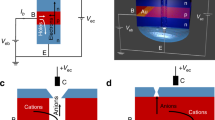Abstract
IN a recent discussion of the transducing mechanism responsible for thermal sensibility, it was argued that, if the free nerve-ending and the extracellular fluid surrounding it could be regarded as a thermocouple, a single sensory mechanism could account for the sensations of ‘warm’ and ‘cold’1. A calculation of the potential difference associated with temperature gradients in homogeneous electrolytic solutions indicated that a thermoelectric effect large enough to account for the depolarization of a nerve fibre would almost certainly have to arise at the interface between the two phases of such an ionic thermocouple. Such an effect, analogous to the Seebeck effect for metallic thermocouples, has not previously been demonstrated, so far as we are aware, for purely ionic systems. The following results show that the effect exists, and is of appreciable size.
This is a preview of subscription content, access via your institution
Access options
Subscribe to this journal
Receive 51 print issues and online access
$199.00 per year
only $3.90 per issue
Buy this article
- Purchase on Springer Link
- Instant access to full article PDF
Prices may be subject to local taxes which are calculated during checkout
Similar content being viewed by others
References
Tyrrell, H. J. V., Taylor, D. A., and Williams, C. M., Nature, 174, 918 (1954).
Author information
Authors and Affiliations
Rights and permissions
About this article
Cite this article
TYRRELL, H., TAYLOR, D. & WILLIAMS, C. The ‘Seebeck Effect’ in a Purely Ionic System. Nature 177, 668–669 (1956). https://doi.org/10.1038/177668b0
Issue Date:
DOI: https://doi.org/10.1038/177668b0
This article is cited by
-
High-performance cryo-temperature ionic thermoelectric liquid cell developed through a eutectic solvent strategy
Nature Communications (2024)
-
Solid state ionics enabled ultra-sensitive detection of thermal trace with 0.001K resolution in deep sea
Nature Communications (2023)
-
Thermal membrane potential across cation-exchange membranes for various halide solutions
Colloid & Polymer Science (1993)
-
Effect of temporal and spatial temperature gradients on the ampullae of Lorenzini
Pfl�gers Archiv European Journal of Physiology (1974)
-
Thermocell with Ion-exchange Polymer Electrolyte
Nature (1958)
Comments
By submitting a comment you agree to abide by our Terms and Community Guidelines. If you find something abusive or that does not comply with our terms or guidelines please flag it as inappropriate.



